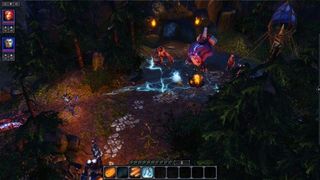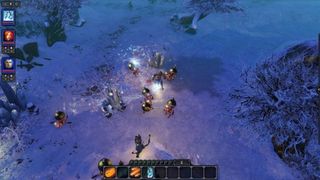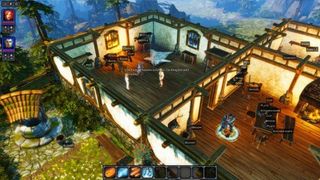Divinity: Original Sin preview

Conversations require dual input. I'm shown an example: both characters are informed of a drug problem among the wollock (think kobolds, but taller) population. Sven and Original Sin producer David Walgrave pinpoint the illegal source of drudanae (Rivellon's take on class A drugs) to a nearby house. After some mild home invasion, the source of the stuff emerges as a local woman. She gives both players the choice: to turn her in, or to help her out, clearing a nearby cave of enemies, sorting her woes and curtailing the drug trade in one move. Sven sticks rigidly to the law, choosing when called first in conversational order to hand her over to the fantasy fuzz. His partner swings the other way, preferring to go adventuring and clearing the woman's name in the process. Sven considers it for a moment, before acquiescing, via written dialogue, to his pal's decision. If they'd disagreed, the decision would be down to a roll against both characters' charisma stats.
David explains how these choices affect your character. “The game will remember the choices you make. If you always make the compassionate choice, we will have an extra skill system. For instance, Sven is always going to be the good cop – he gets +1 doughnut eating, or something like that.”
They also affect the story. Disagree with each other and quests are altered, or even refused. While the other player makes their calls, the non-speaking character stands around, thumbs twiddling – time that can be used to convince your gaming partner of the validity of your choice by in-game chat, Skype, or by shouting loudly from the other side of the room.

It's this latter setup Sven had in mind when he first envisaged Original Sin. “I wanted to play it with my girlfriend. We'd played World of Warcraft screen next to screen, we played Diablo screen next to screen. They were fun because we were playing them together, we were fighting over the items.” Original Sin lets players fight with the items. Sven picks up a barrel and chucks it at David to emphasise the point. This interactivity isn't just for show. David explains the systems behind the game. “In a typical Divinity game you can move and pick up anything that isn't nailed to the ground. I can throw a barrel at Sven. I can also look inside the barrel. I can decide I don't like the barrel and smash it.” There is a tactile simplicity to this philosophy, and it allows for a deep but easily explained crafting system.
“I've picked up a mushroom and a sword, and if I combine these two simply by dragging them over each other I've created a poison sword.” David draws the parallel to Sven's favourite game. “In Ultima, you could bake bread if you found the right ingredients. If you can find grain and water and an oven in Original Sin, you can eat your own bread.” Sven promises “hundreds and hundreds” of these item combinations, from bread to silver coins coated in gold paint to sneakily increase their value. Sven wants to let you interact with everything in the game – including the code itself. Original Sin will come with the editor used to make the game, so modders can create their own campaigns and maps (see 'Make a house a home'), and eventually, Sven says, sell them for money via a sanctioned marketplace.
Original Sin's level of environmental interaction is impressive for an RPG – usually the most static of game genres. To raid the aforementioned drug dealer's house for evidence of her duplicitousness, Sven had to poke around her bedroom. But wade straight in and she'll scream. The solution: David went first, jogging into another room and looking suspiciously at the woman's valuables. Sven then took the time to poke around under a polar bear skin rug, exposing a trapdoor to the magic meth lab below.

Players are free to separate at will, to toddle off and explore a section of the world that's interesting, to complete quests solo if the mood strikes them. This carries over into Original Sin's combat: one player can be hilt-deep in an orc's face while the other is off collecting berries to bake into muffins. Original Sin uses a turn-based combat system – a first for a Divinity game. Skills are arranged along a hotbar and are designed to feed into each other. I'm shown some of the talents along the elementalist skill path as Sven and David get into a fight with a group of wollocks. The unnamed female character waves her arms towards the sky, calling forth a rainy cloudburst and soaking both the wollocks and the ground around them. Skipping out of the puddle, it's up to David – recently joining the battle from the north after investigating some tempting barrels – to deploy an electrical jolt to his friend's foes, dealing extra damage thanks to their drenched skin.
The biggest gaming news, reviews and hardware deals
Keep up to date with the most important stories and the best deals, as picked by the PC Gamer team.
Hit water with an ice spell and it'll freeze, making for an unstable fighting surface. Fire on that ice melts it again, clearing a path for escape or attack. Play cleverly and you can use your skills to escape dangerous scuffles. “There's a line-of-sight rule. You could create an ice shard on the ground and then walk away far enough to leave combat.”
For Sven, the decision to make a turn-based combat system slotted in with Original Sin's top-down viewpoint. He's conscious of the game against its RPG peers: “It's really against the trends of going thirdperson and making everything look like the Unreal engine.”
But Larian have had 15 years of trends, outside influence, and forced decisions. Sven says his focus is on RPG systems and RPG mechanics, pushing to finally make the game he dreamed of after first playing Ultima 7 all those years ago. Without someone looking over his team's shoulder, Divinity: Original Sin is looking like Larian's best shot at Sven's dream yet
Most Popular


